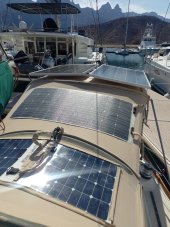felizcortez
New Member
- Joined
- Jun 18, 2021
- Messages
- 4
I am trying to decide on solar panels for on top of my bimini on my boat. I currently have 260W of solar installed via flexible panels that I am looking to upgrade and use more of the space. I currently have 2x50W sunpower flexible panels that are starting to delaminate and discolor, and a single Renogy 160W panel. My measurements on my bimini are 59.5 inches x about 38 inches. I don't want to overhang because it represents a potential hazard on the boat.
I am looking at the Rich Solar 250W panels on amazon, but couldn't find them on the Rich Solar Website. My goal is to maximize the output in the area provided. I'm wondering whether the 250W panels are older and no longer available and whether they are clearing out stock on Amazon. Most everything else I have seen is 200W. The dimensions on the 250 seem to fit inside of my area without overhang so that is attractive.
Any other recommendations or types/sizes or brands of panels I should be looking at?
What is the impression of the Rich Solar panels?
What size charge controller would I need to cover the output of these panels a 100/50 from victron? Or should I split it to two 100/30's? I want to go Victron on the MPPT controllers since I have a Cerbo GX and all my existing charge controllers are linked.
I am looking at the Rich Solar 250W panels on amazon, but couldn't find them on the Rich Solar Website. My goal is to maximize the output in the area provided. I'm wondering whether the 250W panels are older and no longer available and whether they are clearing out stock on Amazon. Most everything else I have seen is 200W. The dimensions on the 250 seem to fit inside of my area without overhang so that is attractive.
Any other recommendations or types/sizes or brands of panels I should be looking at?
What is the impression of the Rich Solar panels?
What size charge controller would I need to cover the output of these panels a 100/50 from victron? Or should I split it to two 100/30's? I want to go Victron on the MPPT controllers since I have a Cerbo GX and all my existing charge controllers are linked.



